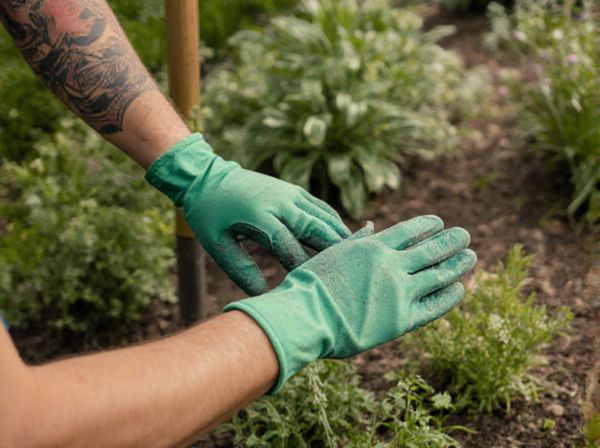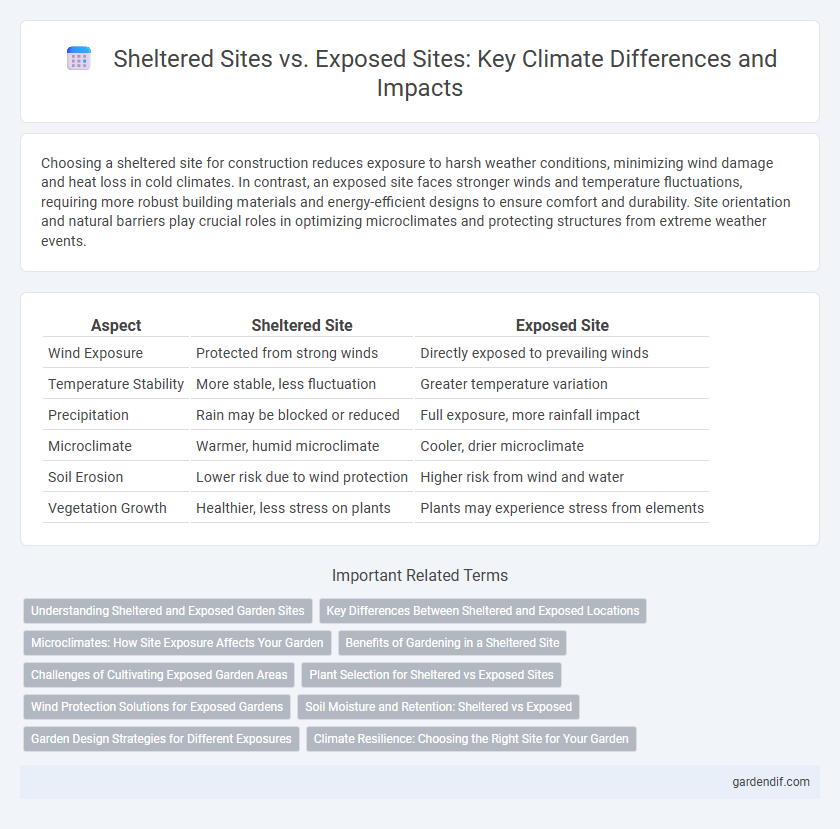
Sheltered Site vs Exposed Site Illustration
Choosing a sheltered site for construction reduces exposure to harsh weather conditions, minimizing wind damage and heat loss in cold climates. In contrast, an exposed site faces stronger winds and temperature fluctuations, requiring more robust building materials and energy-efficient designs to ensure comfort and durability. Site orientation and natural barriers play crucial roles in optimizing microclimates and protecting structures from extreme weather events.
Table of Comparison
| Aspect | Sheltered Site | Exposed Site |
|---|---|---|
| Wind Exposure | Protected from strong winds | Directly exposed to prevailing winds |
| Temperature Stability | More stable, less fluctuation | Greater temperature variation |
| Precipitation | Rain may be blocked or reduced | Full exposure, more rainfall impact |
| Microclimate | Warmer, humid microclimate | Cooler, drier microclimate |
| Soil Erosion | Lower risk due to wind protection | Higher risk from wind and water |
| Vegetation Growth | Healthier, less stress on plants | Plants may experience stress from elements |
Understanding Sheltered and Exposed Garden Sites
Sheltered garden sites offer protection from harsh winds and extreme weather, creating a microclimate that supports delicate plants and extended growing seasons. Exposed sites face direct environmental elements such as strong winds, intense sunlight, and temperature fluctuations, challenging plant resilience and requiring robust species choice. Understanding these differences is crucial for optimizing plant selection, placement, and garden design to maximize growth and sustainability.
Key Differences Between Sheltered and Exposed Locations
Sheltered sites typically experience reduced wind speeds and lower exposure to harsh weather conditions, which helps maintain stable microclimates conducive to sensitive vegetation growth. Exposed sites face higher wind velocities and greater temperature fluctuations, increasing the risk of soil erosion and plant stress. Understanding these differences is crucial for agricultural planning, construction, and ecosystem management to optimize resource use and minimize environmental impact.
Microclimates: How Site Exposure Affects Your Garden
Sheltered sites create microclimates that buffer plants from harsh winds and temperature extremes, promoting healthier growth and reducing water evaporation. Exposed sites experience greater temperature fluctuations, wind stress, and potential frost damage, challenging plant resilience and water retention. Understanding site exposure helps gardeners select appropriate plant species and implement protective measures that optimize microclimate conditions for sustainable garden success.
Benefits of Gardening in a Sheltered Site
Gardening in a sheltered site offers protection from harsh winds, reducing plant stress and preventing damage to delicate foliage. The microclimate created by natural barriers such as walls or dense vegetation helps retain heat and moisture, promoting faster growth and higher yields. This controlled environment minimizes water evaporation and lowers the risk of soil erosion, supporting healthier and more resilient plants.
Challenges of Cultivating Exposed Garden Areas
Cultivating exposed garden areas presents significant challenges due to increased vulnerability to harsh weather conditions such as strong winds, temperature fluctuations, and intense sunlight. These factors can lead to soil erosion, moisture loss, and physical damage to plants, necessitating the use of windbreaks, soil amendments, and drought-resistant plant species for successful growth. Effective management of these environmental stresses is crucial to maintaining plant health and optimizing garden productivity in exposed sites.
Plant Selection for Sheltered vs Exposed Sites
Plant selection for sheltered sites favors species with lower wind tolerance and higher moisture needs, as these areas provide protection from harsh weather and retain soil moisture better. Exposed sites require hardy, wind-resistant plants with deep root systems to withstand strong winds and potential soil erosion. Understanding microclimate variations between sheltered and exposed sites ensures optimal plant growth and landscape resilience in climate-sensitive environments.
Wind Protection Solutions for Exposed Gardens
Exposed gardens benefit significantly from wind protection solutions such as strategically placed windbreaks, including dense shrubbery, trees, or constructed barriers like fences and trellises, which reduce wind speed and prevent soil erosion. Utilizing natural or artificial wind barriers also improves microclimate conditions by maintaining humidity levels and protecting delicate plants from wind stress. Implementing these measures enhances plant growth, conserves water, and increases overall garden resilience against harsh weather conditions commonly experienced in exposed sites.
Soil Moisture and Retention: Sheltered vs Exposed
Sheltered sites typically exhibit higher soil moisture retention due to reduced wind exposure and lower evaporation rates, which enhances water availability for plants. Exposed sites face greater soil moisture loss driven by increased wind and solar radiation, leading to drier soil conditions and reduced retention capacity. Soil texture and organic matter content further influence retention but are often overshadowed by the microclimate effects of site sheltering on moisture dynamics.
Garden Design Strategies for Different Exposures
Sheltered sites in garden design provide protection from strong winds and harsh weather, allowing for the cultivation of delicate plants and creating microclimates that promote growth. Exposed sites require strategic plant selection, structural windbreaks, and durable materials to withstand environmental stress while maintaining aesthetic appeal. Tailoring design strategies to site exposure enhances plant health, conserves resources, and improves garden sustainability.
Climate Resilience: Choosing the Right Site for Your Garden
Sheltered sites offer protection from harsh winds and extreme weather, reducing plant stress and moisture loss, which enhances climate resilience in gardens. Exposed sites, while more vulnerable to temperature fluctuations and wind damage, can benefit from increased sunlight and air circulation, supporting certain drought-tolerant and heat-resistant species. Selecting the right site involves assessing microclimates and aligning plant choices with local climate challenges to maximize garden sustainability and productivity.
Sheltered Site vs Exposed Site Infographic

 gardendif.com
gardendif.com